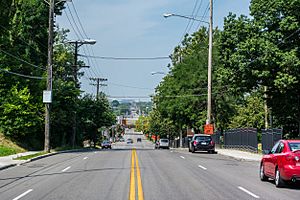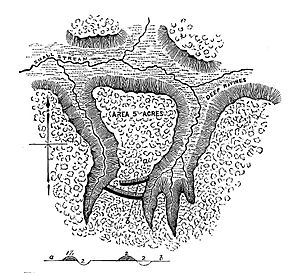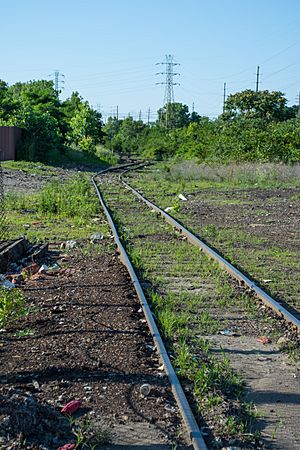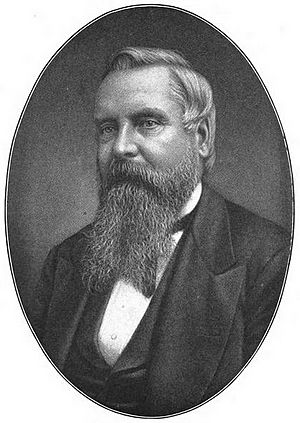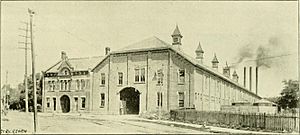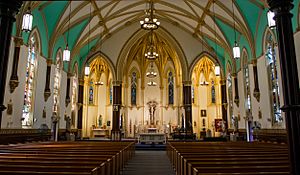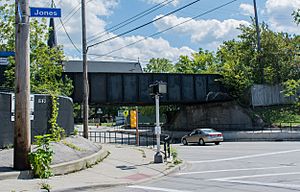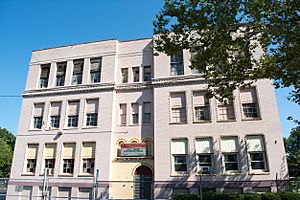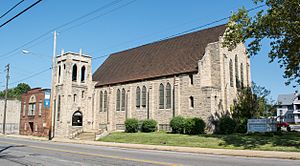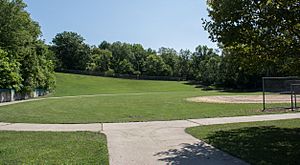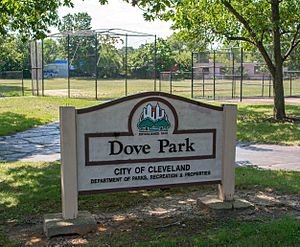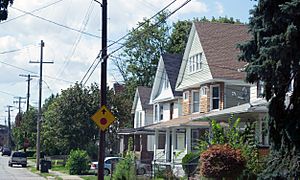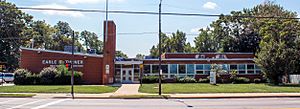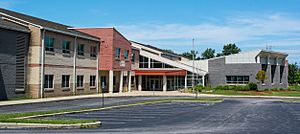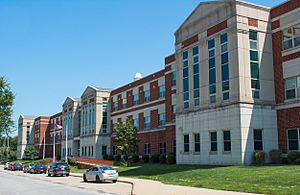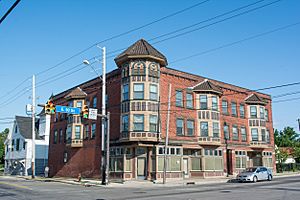Union–Miles Park facts for kids
Quick facts for kids
Union–Miles Park
|
|
|---|---|
|
Neighborhood of Cleveland
|
|

Victorian style houses on Union Avenue
|
|
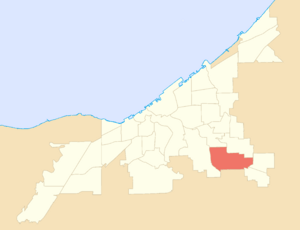
Map of Cleveland, Ohio, showing neighborhood boundaries, with Union–Miles Park in red
|
|
| Country | United States |
| State | Ohio |
| County | Cuyahoga County |
| City | Cleveland |
| Population
(2020)
|
|
| • Total | 16,540 |
| Demographics | |
| • White | 2.7% |
| • Black | 95.6% |
| • Hispanic (of any race) | 1.2% |
| • Asian and Pacific Islander | 0.1% |
| • Mixed and Other | 1.6% |
| Time zone | UTC-5 (EST) |
| • Summer (DST) | UTC-4 (EDT) |
| ZIP Codes |
44104, 44105
|
| Area code(s) | 216 |
| Median income | $26,315 |
| Source: 2020 U.S. Census, City Planning Commission of Cleveland | |
Union–Miles Park is a neighborhood located on the southeast side of Cleveland, Ohio. Its name comes from Union Avenue, which runs through the northern part, and Miles Park, found in its southwest corner. Miles Park was originally the town square of Newburgh Village.
This area was once part of Newburgh Township, formed in 1814. It started as a place for farms and orchards. In 1856, Union–Miles Park became a major center for making steel in Cleveland. This industry attracted many immigrants, including Irish, Scottish, and Welsh people. The area around E. 93rd Street and Union Avenue was even called "Irishtown."
Later, after a strike in 1882, Polish and Slovak immigrants came to work in the mills. They gradually replaced the Irish and Welsh communities. Railroads also played a big role, shaping the neighborhood's layout. The steel industry faced big problems during the Great Depression. In the 1960s, many white families moved away, and more African Americans moved in, looking for affordable homes. Since the mid-1970s, Union–Miles Park has faced challenges like poverty, low education levels, empty houses, crime, and fewer job opportunities.
Union–Miles Park shares borders with several other Cleveland neighborhoods. To the west is Broadway–Slavic Village, to the northwest is Kinsman, and to the north is Mount Pleasant. The Lee–Miles area is to the east, and the city of Garfield Heights, Ohio is to the south.
Contents
Understanding the Land
The land in Cuyahoga County is split into two main types. One part is flatter, called the Till Plains. The other part is hillier, part of the Appalachian Plateau. A natural ridge, the Portage Escarpment, divides these two areas.
In the Union–Miles Park area, this ridge forms a moderate bluff. West of the ridge, the land is mostly flat. East and southeast of the ridge, it becomes hilly with many dry valleys. The Cuyahoga River valley is much lower than the surrounding land. Small streams like Mill Creek also helped shape the area's natural borders. Union–Miles Park is mostly in the hillier part, east of the ridge.
Early Days of the Neighborhood
First People to Live Here
People first lived in northeast Ohio about 11,000 years ago, after the glaciers melted. These early people were hunters who moved around a lot. Over time, different groups lived here, like the Archaic culture and then the Woodland culture. The Woodland people started using pottery and textiles. They built small, temporary camps, often on high spots overlooking rivers. These camps had low earthen walls, which early settlers mistakenly called "forts."
Around 800 CE, the climate got warmer, which was good for farming. A new group, the Whittlesey culture, started growing beans, corn, and squash. They lived in small, permanent villages.
The Whittlesey people disappeared between 1600 and 1650 CE. No one knows exactly why. By the time the Iroquois moved into northeast Ohio around 1650, the area was mostly empty. Later, the Mingo, Odawa, and Wyandot tribes lived here. By 1850, very few Native Americans remained in Ohio.
Two of the Woodland people's "forts" were still visible in Newburgh Township. One was near Broadway Avenue and Aetna Road. It was on a dry piece of land, protected by deep valleys. The other was near the Ohio & Erie Canal Reservation.
White Settlers Arrive
In 1662, the King of England gave the Connecticut Colony land stretching west to the Pacific Ocean. This land included parts of Ohio. In 1786, Connecticut gave most of its land claims to the U.S. government. But it kept a section called the Connecticut Western Reserve, which included what is now Union–Miles Park. In 1795, Connecticut sold this land to the Connecticut Land Company.
The first white settlers in Newburgh Township were David Bryant and his son, Whitman, in 1797. They found dense forests and many wild animals like bison and deer. In 1799, Wheeler W. Williams and Ezra Wyatt built a mill at what is now Mill Creek Falls. A sawmill was added in 1800.
Many early families moved to the higher lands of Newburgh Township to avoid malaria. Charles Miles Sr. moved here in 1805, and his family became very important. The first schools started around 1800. Roads were also built, like Newburgh Street (now E. 93rd Street) and Newburgh Road (now Broadway Avenue).
Newburgh Township was officially formed on October 15, 1814.
Newburgh Township and Village
Early Days of Newburgh Township
For a while, Newburgh Township was almost as important as Cleveland. People even said "Cleveland, the town six miles north of Newburgh." The first public school, Miles Park School, opened in 1818.
Newburgh's importance began to fade after 1826 when Cleveland became the site for the federal courthouse. However, Newburgh Township still grew economically. A village, also called Newburgh, grew up around Broadway and Miles Avenue. In 1828, a "town hall" was built for meetings, church services, and school. Roads were improved, and Newburgh Road was widened and renamed Broadway in 1834.
By 1840, the Village of Newburgh had businesses like a mill, a quarry, and taverns. The Cataract House, a large brick building with a ballroom and restaurant, opened in 1840. Another public school, the Manx Street School, opened in 1843 for the growing Welsh immigrant population.
In 1847, the Cleveland and Pittsburgh Railroad decided to build tracks through Newburgh Township. The railroad opened in 1851, greatly helping the area's economy and social life.
Newburgh Village Before the Civil War
In 1850, Newburgh Township was the fifth-largest area in Cuyahoga County by population. Most people worked in farming. Theodore Miles donated land for a village square in 1850, which later became Miles Park.
In 1852, the state built the Northern Ohio Lunatic Asylum on Turney Road. This hospital, later called Cleveland State Hospital, closed in 1975. The Cleveland and Mahoning Valley Railroad (C&MV) started building tracks through Newburgh in 1853, connecting the area to more places. In 1854, Union Avenue was built and paved, connecting Broadway Avenue all the way to Chagrin Falls.
Union–Miles and the Steel Industry
How Steelmaking Grew in Union–Miles
Newburgh Township's economy quickly grew more diverse in the 1850s. Factories like the Ohio Chair Factory opened. By 1858, the Village of Newburgh had many shops and services.
The Cleveland and Mahoning Valley Railroad, completed in 1856, was key for the steel industry. It brought raw materials to the mills and helped transport finished steel. That same year, the Grasselli Chemical Company opened nearby, attracting Czech and Polish immigrants to the area.
Steel became the biggest industry in Cleveland and Newburgh Township in the 1860s. By 1870, Cleveland was the second-largest iron producer in the U.S. The steel industry helped Cleveland's population grow rapidly. Union–Miles Park became one of Cleveland's two main steel-making areas. The Cleveland Rolling Mill in Newburgh Township was Cleveland's most important factory by 1879.
The Cleveland Rolling Mill Story
The Cleveland Rolling Mill, the most important factory in Union–Miles Park, started in 1856. It was founded by Welsh immigrants David and John Jones to make railway rails. The company faced financial issues but was saved by investments from Scottish immigrants Henry and William Chisholm in 1857. It was renamed Chisholm, Jones and Co.
More investments came in 1860 from Amasa and Andros Stone, and the company became Stone, Chisholm & Jones. They added a blast furnace and a puddling plant. By 1860, the plant had about 150 workers.
On November 9, 1862, the company reorganized as the Cleveland Rolling Mill. They built a large blast furnace in 1864 and their first Bessemer converter in 1865. This made it only the second Bessemer steel works in the United States.
The Cleveland Rolling Mill kept growing. In 1868, they built the Newburgh Steel Works, adding more furnaces and mills. By 1872, the Newburgh plants were producing a lot of iron and steel. The company continued to expand, buying more land and building more furnaces and mills. By 1899, the Cleveland Rolling Mill covered 75 acres in Union–Miles Park and employed 4,000 workers.
In 1899, the American Steel and Wire Company of New Jersey bought Cleveland Rolling Mill. Then, in 1901, American Steel and Wire merged with other large steel companies to form U.S. Steel. This made U.S. Steel control almost all the wire and nail companies in the country.
Other Steel Companies in the Area
By 1859, other metal factories opened near the rail lines in Newburgh Township. Many of these started by reshaping rails but later made finished iron and steel. More than 20 new mills opened between 1860 and 1866. Some important ones included:
- The Cleveland Wire Mill Company (1867), which was the only one of its kind in northern Ohio. Cleveland Rolling Mill bought it later.
- The Aetna Iron and Nail Company (1867).
- The American Sheet and Boiler Plate Company (1868).
- The Cleveland Iron Co. (1869).
- The Union Iron Works (1869), founded by Samuel Augustus Fuller. This mill later became the Union Rolling Mill Co.
- The Gartland Foundry (1893).
How the Steel Industry Changed Union–Miles
The steel mills were mainly in the central and western parts of the neighborhood. They attracted many Irish, Welsh, and Scottish immigrants who came to work in the mills. Many Irish and Welsh workers settled around Broadway Avenue and Jones Road, creating communities like "Irishtown." These workers were often low-paid.
As more workers came, small houses were built close together. Employers sometimes built housing right next to the factories so workers could walk to work. To help workers get to downtown Cleveland, the Broadway Street Railway opened in 1863, using horse-drawn cars. Later, more streetcar lines opened, and by the 1890s, they used electricity. Despite public transit, many workers in Union–Miles Park still walked to work.
By 1860, most people in Newburgh Township worked in the steel industry. The area was even called the "Iron Ward." The mills were noisy and produced a lot of smoke and soot. At night, the glow from the furnaces lit up the sky. The many railroad tracks also divided the neighborhood.
The population boom led to the building of a town hall in 1860. The public square was named Miles Park in 1877, honoring Theodore Miles. New churches were also formed, like the Welsh Congregational Church (1858) and Holy Rosary Church (1862), which later became Holy Name Church.
Even with all these changes, Union–Miles Park was still quite rural in 1873. Most homes were modest, and roads were mostly dirt. Broadway was the only paved street. The area's first newspaper, All Around the Clock, started in 1873.
Village of Newburgh and Its Changes
The Village of Newburgh officially became its own town in 1874. The first fire station opened in 1875, and the first police station in 1876.
Steel Strikes and New People
In 1882, a big strike happened at the Cleveland Rolling Mill. The company brought in many Polish and Slovak immigrants to replace the striking workers. This changed the neighborhood's identity from mainly Irish and Welsh to Polish and Slovak. This also caused tension between the different European groups. Another strike in 1885 also ended with workers being replaced.
The growing population led to a third public school, Woodland Hills School, opening in 1886. The YMCA also opened a gym and meeting center.
Railroads and Cemeteries
Another major railroad, the Connotton Valley Railway, built its line through Newburgh starting in 1881. This line connected Cleveland to other cities. The old Axtell Road Cemetery was moved in 1880 to make way for the railroad. Over 3,000 bodies were moved to the new Harvard Grove Cemetery. In 1892, Calvary Cemetery, a large Catholic burial ground, was established.
Public transportation continued to grow. Streetcar lines merged to form larger companies. The first interurban train, the Akron, Bedford and Cleveland Railroad, reached Newburgh in 1895, connecting it to Akron. The neighborhood also got its first public library branch in 1894, located in the Newburgh Town Hall.
The last major railroad, the Newburgh and South Shore Railroad, was built from 1899 to 1904. It connected the steel plants in Newburgh to those near the port of Cleveland. By the end of the 1800s, the neighborhood was mostly populated by Polish and Slovak immigrants.
How Union–Miles Park Grew with Cleveland
Early Annexations
Newburgh Township was formed in 1814. Cleveland became a village shortly after. Over time, Cleveland grew and started adding parts of Newburgh Township. In 1836 and 1850, small sections of Newburgh were added to Cleveland.
Even though Newburgh Township had many factories, it lacked basic services like fire protection, police, and fresh water. Many residents wanted to become part of Cleveland to get these services.
Annexation Wave (1869–1873)
Cleveland annexed most of Newburgh Township, including about half of Union–Miles Park, between 1869 and 1873. This happened as Cleveland grew and wanted to include both undeveloped land and already developed areas.
Large sections were added in 1867 and 1869. On November 19, 1872, a big part of Newburgh Township, including the northern northwest corner of Union–Miles Park, was annexed. This brought Cleveland's city limits right up to the Village of Newburgh.
Finally, on September 16, 1873, the Village of Newburgh agreed to be annexed by Cleveland. This brought the entire western half of Union–Miles Park into the city.
Later Annexations
More parts of Newburgh Township were added to Cleveland over the years. A small part was added in 1893. In 1904, the part of Newburgh Township west of Mill Creek became the Village of Newburgh Heights. Cleveland annexed a small part of Newburgh Heights in 1905.
In 1907, the southern part of Newburgh Township became the village of South Newburgh, which later became the city of Garfield Heights, Ohio. Cleveland annexed the Village of Corlett in 1909, bringing the southeast corner of Union–Miles Park into the city. The rest of Newburgh Township was annexed by Cleveland in 1913.
The Name Union–Miles Park
Cleveland neighborhoods often get their names from how people living there identify with the area. The name "Union–Miles Park" started appearing in advertisements for homes around 1926. The Plain Dealer newspaper first used the name in 1930. It became more common after the Union–Miles Community Coalition formed in 1979.
Union–Miles Park in the 1900s
Before the Great Depression
In 1904, the old Newburgh Town Hall was moved to make way for a new library. In 1905, Mill Creek Falls was moved about 300 feet south to allow for new railroad tracks. Many areas of Union–Miles Park were still undeveloped in the early 1900s. Roads were often dirt, making travel difficult.
However, the population grew, leading to more social buildings. A new library was built from 1906 to 1907. The neighborhood's population more than doubled from 11,000 in 1910 to 28,000 in 1930. New Catholic churches and schools opened, like St. Catherine Church (1898) and Nativity of the Blessed Virgin Mary Church (1903), which served the Slovak community.
The steel industry remained important. Champion Rivet moved its factory in 1901. Other metal companies like Champion Machine and Forging (1908) and Allyne-Ryan Company (making car parts) also opened. The fourth public school, Boulevard School, opened in 1910 to help with overcrowding.
More churches were founded in the 1910s and 1920s, including St. Joseph Byzantine Catholic Church (1909) and Concordia Lutheran Church (1914) for African Americans. The Milo Theater, the first movie theater, opened in 1918. Paul Revere Elementary School opened in 1920.
The Great Depression: Steel Industry Struggles
The Great Depression caused the steel industry in Union–Miles Park to collapse. U.S. Steel closed its Newburgh Works in 1933, leading to 2,000 job losses. The plant was demolished in 1935.
Despite this, new schools and buildings were still built. John Adams High School, the first high school in the area, opened in 1923. Nathan Hale Elementary School opened in 1928. The library moved into a new building in 1939.
Churches also expanded. St. Joseph Byzantine built a larger church in 1933. Miles Park School added an auditorium and gym. Union–Miles Park got its first public park, Bisbee Park, in 1939, thanks to local efforts and federal help.
1940 to 1959: Slow Changes
Simmons Manufacturing bought the old Superior Screw building in 1933. During World War II, it was used to make war materials. The city built a second public park, Dove Park, in 1948.
Cleveland's steel industry continued to shrink in the 1950s. Some companies closed or merged. However, the demand for special types of steel helped a bit. Union–Miles Park remained a neighborhood with many Central and Eastern European families. New Catholic churches and schools were built or expanded in the 1950s. Still, the population of Union–Miles Park dropped by 19% between 1940 and 1960.
1960 to 1979: Big Changes in People
| Historical population | ||
|---|---|---|
| Year | Pop. | ±% |
| 1930 | 28,000 | — |
| 1940 | 26,548 | −5.2% |
| 1950 | 24,948 | −6.0% |
| 1960 | 23,010 | −7.8% |
| 1970 | 23,214 | +0.9% |
| 1980 | 19,299 | −16.9% |
| 1990 | 17,338 | −10.2% |
| 2000 | 15,464 | −10.8% |
| 2010 | 19,004 | +22.9% |
| Sources: | ||
U.S. Steel slowly closed its Cleveland operations in the 1960s and 1970s. This meant a loss of good-paying factory jobs. Many Czech, Polish, and Slovak families moved out of Union–Miles Park to the suburbs.
This movement of people caused problems. Many property owners stopped taking care of their homes. Houses were abandoned, leading to lower property values, more crime, and vandalism. This hurt the churches and social groups that these communities supported.
At the same time, more African Americans moved into Union–Miles Park. They had been limited to other parts of Cleveland but now found affordable, empty homes in neighborhoods like Union–Miles Park. By 1980, 90% of the neighborhood's residents were African American.
Some churches merged or closed as their congregations changed. However, the Cleveland public school system continued to invest. A new Miles Park School opened in 1971, and a new Woodland Hills School was completed in 1973.
In 1977, Archangel Michael Orthodox Church moved out of the neighborhood. Miles Park Methodist Church closed in 1978. By 1979, Union–Miles Park faced high crime and decay. Residents formed the Union-Miles Community Coalition to advocate for better housing and city services.
1980 to 1999: Challenges and Efforts to Rebuild
Recessions in the early 1980s hit Union–Miles Park hard. Many residents lived below the poverty line. St. Joseph Byzantine Church moved in 1980. The Boulevard School closed due to fewer students.
The Union-Miles Community Coalition became more organized. In 1981, they formed the nonprofit Union Miles Development Corporation (UMDC). UMDC worked to improve housing and encourage banks to lend money in the area. In 1982, a new Union Branch library was built.
U.S. Steel closed its last large plant in Cleveland in 1984. The historic Newburgh Town Hall burned down in 1984 and was demolished in 1985. Many homes were abandoned or torn down. By 1989, 35% of homes faced foreclosure.
By the late 1980s, Union–Miles Park was a neighborhood in transition. Some African Americans moved in, while others moved to the suburbs. The population continued to drop. By 1990, 95% of residents were African American, and over 60% lived in poverty, making it one of Cleveland's poorest neighborhoods.
In the 1990s, the population continued to decline. John Adams High School closed in 1995 and was torn down. Mt. Pleasant School also closed. Nativity of Blessed Virgin Mary Church closed in 1992 due to a dwindling congregation.
Union–Miles Park in the 2000s
Stabilization and New Schools
The decline of Union–Miles Park slowed down in the early 2000s. The population actually increased by 22.9% from 2000 to 2010.
Some older churches closed or moved, and new ones took their place. The old Miles Park library building was renovated in 2000 and became the headquarters for the Union-Miles Neighborhood Development Corporation. A new park and walking trail were completed at Mill Creek Falls in 2002. In 2004, the city bought the YMCA building and turned it into the Earle B. Turner Recreation Center.
Schools in the area also saw improvements. The Cleveland public school system started a big program to build and fix schools in 2002. A new Miles Park School opened in 2007. The Miles School and Nathan Hale School were also rebuilt. Woodland Hills School closed in 2011 and was sold to a charter school company. Paul Revere Elementary School closed in 2012.
A new John Adams High School opened in 2006. In 2016, the school district decided to change John Adams into a Bard High School Early College, which opened in 2017.
Neighborhood Economy Today
The factories in Union–Miles Park are mostly located along the railroad tracks. As of 2004, about 30 medium to large manufacturing companies were in the neighborhood. These included companies making building materials, chemicals, and metal products. Many of these businesses are family-owned and have been around for a long time.
However, there were many empty or unused industrial properties. Most of these had environmental issues from past industrial use, making them hard to develop. Union–Miles Park no longer has main shopping areas. Retail stores are spread out, and there were many empty retail spaces in 2004.
Neighborhood's Economic and Social Layout
Union–Miles Park is somewhat close to downtown Cleveland and the University Circle area, but it feels a bit cut off. E. 93rd Street is the only major north-south road, and it has railroad crossings that cause delays. The main east-west roads (Harvard, Miles, and Union Avenues) don't go directly downtown. The many railroad lines also separate the neighborhood from other parts of the city. Changing these rail lines is not easy to do.
Public transportation in Union–Miles Park relies on RTA bus lines. There are no light rail stations in the neighborhood.
Notable People and Places
Famous People from Union–Miles Park
Several well-known people were born or lived in what is now Union–Miles Park:
- Thomas Coughlin (1876–1967), a Cleveland City Council member and Ohio state legislator.
- Harry L. Davis (1878–1950), who was both the mayor of Cleveland and the governor of Ohio.
- William R. Hopkins (1869–1961), Cleveland's city manager.
- Dr. John Toomey (1889–1950), an expert on polio.
- Robert Ward (1917–2013), a famous composer.
Important Places in Union–Miles Park
Several important buildings and areas are found in Union–Miles Park:
- Cermak Building, at 3503 E. 93rd Street. Built in 1909, this building was a key part of the Slovak neighborhood. It is listed on the National Register of Historic Places.
- Miles Park Historic District, located around Miles Park Avenue between E. 91st and E. 93rd Streets. This district includes Miles Park (the old village square), the 1907 Miles Park Library, and two historic churches: the 1872 Miles Park Methodist Church and the 1870 Miles Park Presbyterian Church. This district is also listed on the National Register of Historic Places.


